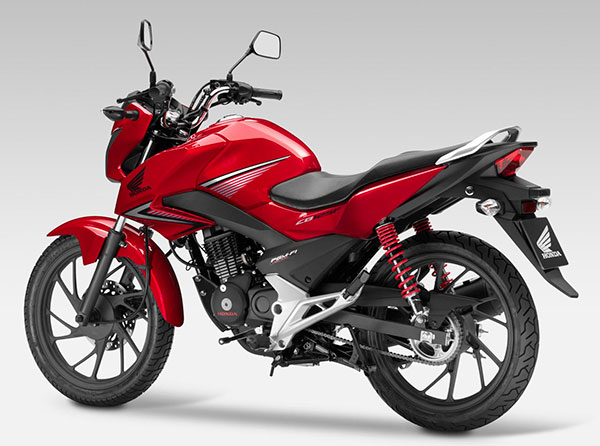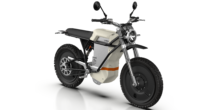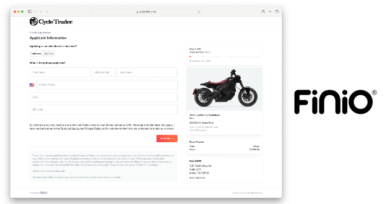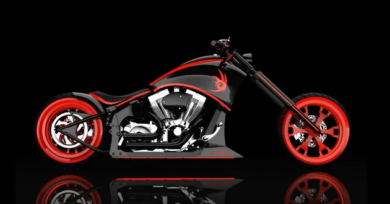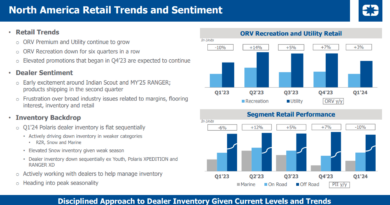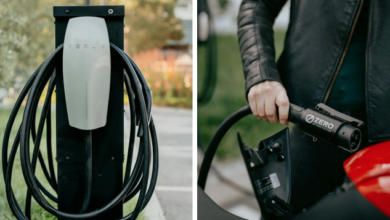Honda unveils 2015 CB125F for European market
News release
Model updates: The CB125F is extensively revised with CB-F family ‘naked’ style plus a responsive new chassis and six-spoke 18-inch wheels. Built for real-world usability, its new air-cooled engine delivers strong low to mid-range torque, and features a balance shaft and revised PGM-FI settings. Build quality is also enhanced, while purchase and ownership costs remain outstandingly attractive.
An entry-level 125cc motorcycle has to be a multi-faceted machine. To some it represents the most economical way of getting from A to B, both in terms of initial affordability and running costs. To these riders it must be durable, easy to live with and economical: simple, trouble-free transport at its most fundamental.
But to many new riders a 125 is the start of their motorcycling adventure, their first ‘real’ bike. So it must deliver all of the above and everything else that a motorcycle should – the excitement, freedom and instinctive pleasure that two wheels bring to everyday life. Yet it also has to be easy for a novice to manage as he/she learns, with build quality that instills tangible pride of ownership and style that adds street credibility.
For any manufacturer, welcoming and introducing fresh entrants to their brand is important. The right initial experience can lead to a lifelong association, especially when a family progression is built into the line-up for when age and experience advance.
Honda’s CBF125 has long proved a tough, user-friendly entry-level motorcycle. The new 2015 CB125F is drawn from a fresh gene pool and while it maintains the previous model’s core strengths, it builds heavily on quality, ease of use and a desirable new look. It’s a great bike to simply get you where you need to be – or from where to begin the ride of a lifetime.
- Model Overview
The new CB125F has been styled with a strong family resemblance to the twincylinder CB500F and four-cylinder CB650F. An injection of aggressive ‘streetfighter’ attitude matches an upright riding position and wide handlebars, giving excellent control.
An all-new steel frame provides strength, with geometry for all-round reactive and confident handling. Revised 18-inch (from 17-inch) wheels iron out surface imperfections and aid stability, as do the telescopic forks and twin rear shocks.
Powerful but novice-friendly braking is delivered by a hydraulic caliper and disc up front with a drum rear.
Heart and soul of the new CB125F is its robust fuel-injected single-cylinder engine.
The engine has been developed to deliver strong low and mid-range torque with crisp throttle response. It provides brisk acceleration in busy urban situations, is easy to manage and smooth at all rpm thanks to the addition of a balancer shaft. It’s also economical and a ready starter in challenging weather conditions thanks to use of the latest design PGM-FI system.
For the end user the other good news is that the 2015 CB125F, armed with an array of improvements plus Honda engineering and high quality finish arrives in dealers at a highly competitive price point.
- Key Features
3.1 Styling & Chassis
With strong desire for naked motorcycles of all capacities throughout Europe, the CB125F channels its larger siblings’ street style with a broad-shouldered and muscular ‘mass forward’ stance. Angular side shrouds extend forward from the fuel tank and the contoured side cowls narrow neatly, minimizing the height difference between rider and pillion.
The compact nose cowl surrounding the multi reflector headlight and dash display completes the aggressive new look. Clear indicator lenses and orange bulbs add a stylish finishing touch.
The engine, exhaust downpipe and muffler, fork lowers and wheels are blacked out, underlining the crisp lines and bright paintwork. Subtle red detailing is to be found on the shock springs and Honda logo on the engine crankcases. It’s a bike built to endure the rigours of European weather, whilst its new style, build quality and finish add greatly to owner satisfaction.
As a machine that will see use as every day commuter, riding school stalwart and open door to the world of motorcycling, its riding position is upright and relaxed, with more forward-set footpegs and wide handlebars (pulled back slightly, with 45° lock left and right) giving optimum control, rider confidence and all-round visibility. Seat height is 775mm.
The integrated steel frame suspends the engine from a sturdy central spine and features geometry that provides the best balance between ride comfort and straight line stability, with a focus toward light steering input and sporty feel at all lean angles.
Rake and trail are set at 26° and 97mm with wheelbase of 1295mm. Kerb weight is just 128kg.
Dual rear shocks offer 5-step spring preload adjustment and complement the 120mm telescopic fork’s compliance and ride quality; stylish six-spoke 18-inch aluminium front and rear wheels increase stability and ride quality over rough city streets. Tyres are sized 80/100 front and 90/90 rear. A 240mm front disc is worked by a double piston caliper, with back up from the 130mm rear drum.
The CB125F will be available in four colour ways:
Pearl Twinkle Yellow
Onyx Blue Metallic
Pearl Sunbeam White
Candy Blazing Red
3.2 Engine
The CB125F’s 124.7cc, air-cooled fuel-injected OHC 2-valve engine is tough, proven and efficient. Bore and stroke is set at 52.4 x 57.8mm, with compression ratio of 9.2:1. The cylinder head has been revised for 2015 and the addition of a balancer shaft neutralises vibration. The 5-speed gearbox provides a wide spread of useful ratios. Peak power of 7.8kW arrives at 7,750rpm, with maximum torque of 10.2Nm delivered at 6,250rpm.
But numbers tell only half of the story; focus of the engineering team was around the powerplant’s real-world user friendliness – in other words, strong low and mid-range torque, with excellent throttle response for smart acceleration from a standstill in urban riding. The engine’s pick up and throttle response is noticeably stronger.
Fuel economy of 51.3km/l (WMTC mode) provides a range of over 600km between
fill-ups from the 13-litre tank and the PGM-FI employs the latest solenoid, making for much easier starting in extreme cold or adverse weather.
- Technical Specifications
ENGINE
Type Air-cooled 4-stroke 2-valve OHC
single with balancer shaft
Displacement 124.7cc
Bore Stroke 52.4mm x 57.8mm
Press information for CB125F 2015
Compression Ratio 9.2:1
Max. Power Output 7.8kW @ 7,750rpm
Max. Torque 10.2Nm @ 6,250rpm
Oil Capacity 1.0 litres
FUEL SYSTEM
Carburation PGM-FI electronic fuel injection
Fuel Tank Capacity 13 litre
Fuel Consumption 51.3 km/litre
ELECTRICAL SYSTEM
Starter Electric
Battery Capacity 12V/6AH
ACG Output 202W
DRIVETRAIN
Clutch Type Wet, multiplate with coil springs
Transmission Type 5 speed
Final Drive Standard chain
FRAME
Type Diamond; steel
CHASSIS
Dimensions (LWH) 2035mm x 765mm x 1080mm
Wheelbase 1295mm
Caster Angle 26°
Trail 97mm
Seat Height 775mm
Press information for CB125F 2015
Ground Clearance 160mm
Kerb Weight 128kg (Front 58kg; Rear 70kg)
SUSPENSION
Type Front 120mm telescopic fork (31mm diameter)
Type Rear Dual rear shocks with 5-step spring preload adjustment
WHEELS
Type Front 18” six spoke cast aluminum
Type Rear 18” six spoke cast aluminum
Rim Size Front 18M/C MT1.85
Rim Size Rear 18M/C MT2.15
Tyres Front 80/100 – 18M/C 47P
Tyres Rear 90/90 – 18M/C 51P
BRAKES
Type Front 240mm disc with double piston calliper
Type Rear 130mm drum
INSTRUMENTS & ELECTRICS
Instruments Speedometer, milometer, fuel gauge, rpm counter, gear indicator
Headlight 12V 35W (low), 35W (high)
Taillight 12V 21W (stop), 5W (tail)
All specifications are provisional and subject to change without notice.
** Please note that the figures provided are results obtained by Honda under standardised testing conditions prescribed by WMTC. Tests are conducted on a rolling road using a standard version of the vehicle with only one rider and no
additional optional equipment. Actual fuel consumption may vary depending on how you ride, how you maintain your vehicle, weather, road conditions, tire pressure, installation of accessories, cargo, rider and passenger weight, and other factors.

